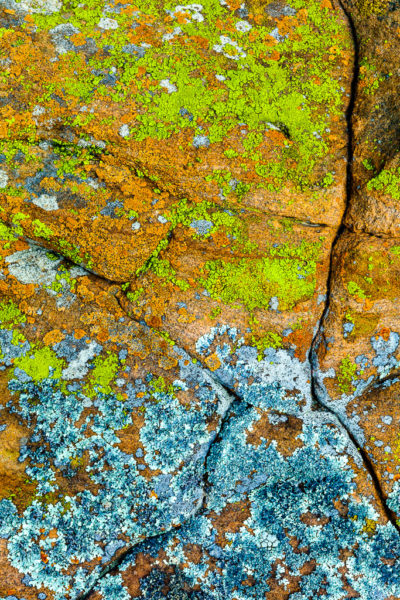After stopping at Lake Bailey, I continued on toward the rock formation known as Turtle Rocks. The formation gets its name from its resemblance to turtle shells. No one really understands how this type of formation is created, but one theory is they are formed through a type of chemical weathering. This occurs when water moves through not only the rock but also through individual sand grains. The sand grains then loosen and separate from the rock, which widens the rock’s natural fractures creating a rounded, turtle-like shape. Regardless of how they are formed, the turtle rocks are a very unique and interesting thing to see.
My goal when I arrived was to focus not on the overall formation itself but rather on the patterns of cracks and crevices in the rock. I thought these patterns would create some very interesting abstract images. I waited for the sun to rise above the trees so the rocks would be lit from the side. This angled light would help emphasize the texture of the rock surface and provide contrast between the brightly lit surface and the dark cracks within the rock.
As I photographed various crack patterns, I began noticing the various lichens that had grown on some of the rock surfaces. What caught my attention were all the different colors they displayed. I took numerous pictures of the lichen on the rocks, but this one is my favorite.
This image was taken on the shaded side of a boulder. This provided soft, even lighting which is perfect for this kind of photograph. Had it been on the brightly lit side, the lighting would have been too harsh and would have washed out the colors that originally caught my eye.
My biggest concern was ensuring I maintained complete depth of field. If any part of the picture was not in sharp focus, that area would have been visually distracting. It would continually draw the viewer’s eye to that one portion of photograph and taken attention away from the overall image. To get the most depth of field possible, I positioned the camera so that the plane of the image sensor was parallel to the plane of the rock surface. By positioning the camera in this way, all points of the subject are the same distance from the sensor. If the subject is completely flat, any aperture can be used, and the entire image will be sharp.
However, this subject was not completely flat. There were some slight ridges and valleys in the rock surface, and the lichen itself were slightly higher than the rock face they were growing on. To compensate for all this unevenness, I used the smallest aperture on the lens, f/22. This required a slower shutter speed, but this wasn’t a concern since nothing was moving.
Settings: 70mm, 1/13 sec, f/22, ISO400

Pingback: Lichen on Rock | Bob Henry Photography
Pingback: 2018 Year in Review | Bob Henry Photography